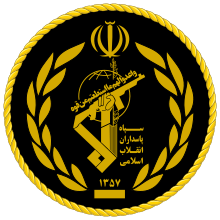Khatam-al Anbiya Construction Headquarter
| Khatam Ghorb | |
Native name | خاتمالانبیا |
| Public | |
| Industry | Engineering |
Key people |
Abolghasem Mozaffari (Managing Director) Abdolreza Abedzadeh (Deputy Director) |
Number of employees | 25,000 |
| Parent | IRGC |
| Website |
khatam |
Khatam al-Anbiya Construction Headquarter (also spelled Khātam al-Anbiyā, Persian: قرارگاه سازندگی خاتمالانبیا; literally, "Seal of the Prophets") is an Iranian engineering firm controlled by the Iranian Revolutionary Guard Corps (IRGC). The firm, also known as GHORB, is the IRGC's major engineering arm and one of Iran's largest contractors in industrial and development projects. Khatam al-Anbiya was created during the 1980–88 Iran–Iraq war to help rebuild the country, and has diversified over the years into companies dealing with mechanical engineering, energy, mining and defense.
Foundation
After the Iran–Iraq War (1980–88), the Iranian government encouraged the IRGC to bolster its budget through economic activities. To do so, the IRGC established a headquarters of self-sufficiency and a headquarters of reconstruction. In 1990, the headquarters of reconstruction became gharargah sazandegi khatam alanbia, abbreviated as Ghorb. In time, the firm became "one of Iran’s largest contractors in industrial and development projects, and today is considered the IRGC's major engineering arm."[1]
Business activities
Khatam al-Anbia is a giant holding firm with control of more than 812 registered companies inside or outside Iran, and (as at 2012) the recipient of 1,700 government contracts.[2] It is said to have a workforce of 25,000 engineers and staff. Ten percent of the employees are IRGC members while the rest are contractors. According to the firm's website, the company has been awarded contracts in various construction fields "including dams; water diversion systems; highways; tunnels; buildings; heavy-duty structures; three-dimensional trusses; offshore construction; water supply systems; and water, gas, and oil main pipelines."[1]
Two of the most prominent Khatam subsidiaries are Sepasad and Hara; the former is currently constructing Line Seven of the Tehran Metro, while the latter directs tunnel construction and excavation operations throughout the country.[1]
On April 25, 2009, a consortium controlled by Khatam purchased a 51.18% controlling stake in Iran's naval-industrial giant SADRA.[3]
South Pars
As part of the IRGC, Khatam al-Anbiya is intimately connected to Iran's oil and gas industry. The company has been awarded several phases of the South Pars gas field. In May 2010, the Iranian government awarded Khatam the rights to develop phases 13, 14, 22, 23 and 24 of South Pars.[4] On April 30, 2011, Iran's Oil Ministry awarded two no-tender contracts to Khatam to develop the Halgan and Sefid Baghoon gas fields in South Pars.[5]
Activities abroad
In May 2011, the German newspaper Die Welt reported that Iran is building intermediate-range missile launch pads for its Venezuelan allies on the Paraguaná Peninsula of Venezuela. Khatam al-Anbia is reported to be actively assisting on the project.[6]
Sanctions
United States
On October 25, 2007, the U.S. Department of Treasury's Office of Foreign Assets Control (OFAC) added Khatam to the Specially Designated National (SDN) list. Pursuant to Executive Order 13382, which targets proliferators of weapons of mass destruction and their delivery systems, this action freezes the company's assets under U.S. jurisdiction and prohibits transactions with U.S. parties.[7]
European Union
On June 24, 2008, the European Union listed Khatam as an entity linked to Iran's proliferation-sensitive nuclear activities or Iran's development of nuclear weapon delivery systems. With a few exceptions, EU member states are required to freeze all funds and economic resources owned, held or controlled by the Khatam, and must ensure that no funds or economic resources are made available to or for the listed company.[7]
United Nations
United Nations Security Council Resolution 1929, adopted on June 9, 2010, targets Khatam as an entity "controlled, or acting on behalf of the Islamic Revolutionary Guard Corps."[8][9]
See also
- Imensazen Consultant Engineers Institute (subsidiary of Khatam al-Anbiya)
- Fater Engineering Institute (subsidiary of Khatam al-Anbiya)
- Economy of Iran
- Construction in Iran
- Industry of Iran
- Energy in Iran
- Military of Iran
References
- 1 2 3 Wehrey; et al. "The Rise of the Pasdaran: Assessing the Domestic Roles of Iran's Islamic Revolutionary Guards Corps". RAND. p. 60. Retrieved 2010-01-23.
- ↑ Borger, Julian; Tait, Robert (15 February 2010). "The financial power of the Revolutionary Guards". The Guardian. London.
- ↑ Ardalan Sayami (23 March 2010). "1388: Year of Militarization of Iran's Economy". Payvand News.
- ↑ "Iran awards Pars gas phases to Revolutionary Guards: report". AFP. 28 May 2010. Retrieved 20 May 2011.
- ↑ "Iran awards gas projects to Revolutionary Guard". AP. 30 April 2011. Retrieved 20 May 2011.
- ↑ Benjamin Weinthal (17 May 2011). "'Die Welt': Iran building rocket bases in Venezuela". The Jerusalem Post. Retrieved 20 May 2011.
- 1 2 "Iranian Entity: Khatam ol Anbia Gharargah Sazandegi Nooh". Iran Watch. Retrieved 3 February 2010.
- ↑ "Security Council imposes additional sanctions on Iran, voting 12 in favour to 2 against, with 1 abstention". United Nations. 9 June 2010. Retrieved 8 July 2010.
- ↑ Benoît Faucon (16 July 2010). "Sanctioned Iran Group Pulls Out of Gas Project". The Wall Street Journal.
External links
- Khatam al-Anbiya Official Website (Persian)
